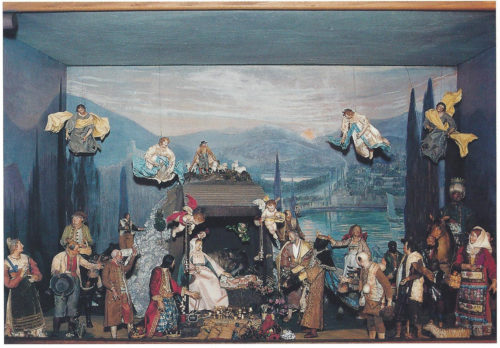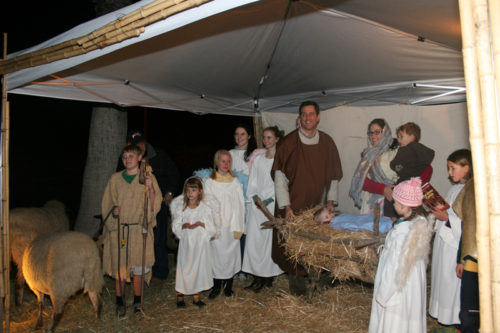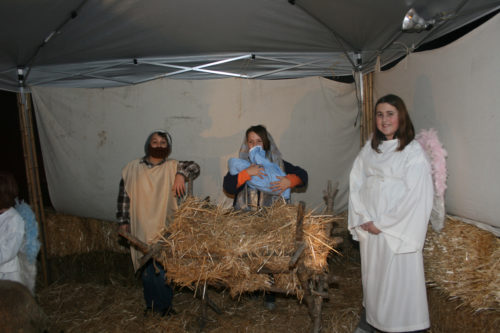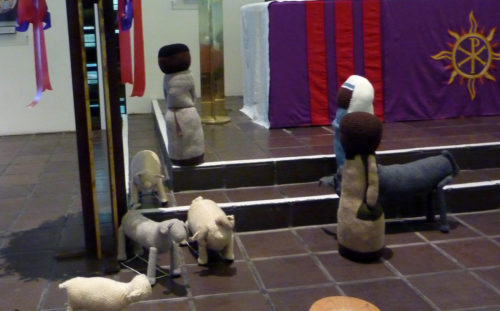Creches and nativities, living or otherwise, tell the Christmas storyPosted Dec 20, 2013 |
|
[Episcopal News Service] It wasn’t so much the donkey in Grace Church’s living Nativity scene that surprised Benjamin de Leon, as the llama.
“It was great fun, interesting because you’re outside in a little manger. There was a donkey there, and a llama, definitely some animals,” recalled de Leon, 41, who served as Joseph a few years ago in the San Marcos, California church’s outdoor living nativity.
Along with wife Lara, as Mary; daughters Abigail and Elena as angels and then-four-month-old Charlotte as the infant Jesus, the family enjoyed “a wonderful experience. It makes you think about what Christmas really means, instead of just presents and Santa Claus. It’s such an important thing to do because you’re playing the holy family.”
The San Diego area congregation has offered the living nativity “as a gift to the community” for the past four years, according to Grace communications director Teresa Osborne.
A parishioner who rescues animals provides sheep, a donkey, and even the llama. The scene is aglow with luminaries. There’s even a “Bethlehem star,” and a one-sided tent doubles as a stable and is the backdrop for the handmade wooden crèche and manger, Osborne said. And there’s always room for one more angel so everyone can get into the act, she said.
Church members sign up for half-hour shifts to create the tableau; this year, the event has grown from one to two nights and will include a pageant.
“It’s in a very visual spot so people driving by can see it,” Osborne said. “People tell us they get excited when they see it.”
Reverence of and fascination for nativity scenes and crèches (cribs) – living or otherwise – dates to the Middle Ages, when tradition says St. Francis of Assisi created the first one after visiting the Holy Land and Christ’s birthplace.
A global tradition, the representations of Jesus’ birth stories from the gospels of Luke and Matthew vary; so does their use.
Some churches’ crèche displays – like the Washington National Cathedral’s well-known exhibit – are seasonal. Others, however, and even some individual collectors, enjoy them year-round.
“I probably have close to 50 different nativities from all over the world: Germany, Italy, Austria, Africa, Mexico, the United States and Haiti,” said the Rev. Sally Monastiere, of Upland, California, who has collected crèches for more than 20 years. Some she displays year-round; others only seasonally.
“The figures in the African one are in native dress,” she said. “One from France has the figure of Joseph in a seated position and Mary is reclining. One of the most unusual has Joseph holding the baby. Another I got because it had chickens. I’ve even created a nativity in cross-stitch and own one knit in the manner of the duduza dolls of Haiti.”
In Upland, California, ‘Mary is everybody’s mother’
Lisa Drew, who created Monastiere’s duduza-style nativity, also knitted a two-foot, cuddly, hands-on crèche for St. Mark’s Episcopal Church and School in Upland so kids – big and little – could touch and feel and handle and “get to use the figures and tell the stories with them.”
“My seventh grade math class had a lot of questions about it, so we took a crèche tour,” said Drew, a math teacher, counselor and parishioner at St. Mark’s. “Here were 12- and 13-year-olds doing what I had envisioned four and five-year-olds doing. They were picking up the animals and moving them around, rearranging them, hugging the lamb and the sheep. It was fun.”
Drew was inspired after attending a knitting afternoon hosted by For a Reason, a nonprofit agency which raises funds for educational opportunities, including in Haiti where St. Mark’s has partnered with St. Andre’s School in Trianon for more than a dozen years.
It reawakened her interest in knitting and she decided to model a nativity after the Haitian duduza dolls.
“I had to make stands and wire skeletons for the critters – there was no pattern, so I was just knitting what I thought would be an animal shape.”
Using PVC pipe and copper wire for skeletons, yarn and polyester stuffing for bodies and green floral styrofoam for stands, she created a family of three sheep – a ram, ewe and lamb – a goat, and a donkey in addition to Mary, Joseph, an angel, a wise man and “a baby which detaches so we can tell the story leading up to the birth of the baby without the baby there,” said Drew.
“Mary’s veil and Gabriel’s wings are seed-stitched, which is rather laborious, but gives them a veil-like texture which is fun to make,” she added.
Ultimately, the effort is about teaching children how to tell the story. “It was very much about the children who would get to use these figures and the stories that they could tell with them,” Drew said. “The idea was to try to envision the crèche in a new way, to try to envision it in a way that included our Haitian partners and that the nativity is available to all people of all colors in all places.”
She used yarn to emulate the skin tone of the Haitian dolls “because Mary is everybody’s mother, everybody’s daughter. She’s the woman we all wish we could be that could say yes to God like that and Joseph is that obedient man, who also said yes to God.”
Atlanta: A natural connection to the holy family
It isn’t easy to describe the carved, wooden, mid-19th century, 4×5-foot Italian relief displayed year-round in the narthex of Holy Innocents Church and School in Atlanta, according to the Rev. Michael Radford Sullivan, rector.
“How do you describe something that’s holy?” he asked during a recent telephone interview with ENS.
The slab’s delicate carving renders clothing and other details almost sketch-like; the figures seem to emerge from the wood, he said. “What you really notice are the faces and the beauty of the people. It has a remarkable, incarnate quality.”
And he added: “Since we are Church of the Holy Innocents, we have a natural connection all year to the holy family and so this is actually in the narthex and so it’s there all the time. It’s an absolutely beautiful carved piece.”
But like most churches, another crèche – about a foot high and made of olive wood – is seasonally placed near the altar. “Its pieces usually start appearing in the narthex over the four Sundays of Advent – first a cow, then a sheep and shepherds,” Sullivan said. “Mary shows up on the third Sunday of Advent and on Christmas Eve Jesus is placed in the manger.”
One of the cool things is that “the crèches, both on the wall and the one that will be at the altar, are experienced by school children year-round as well,” he added.
“There’s something about living with the image of Jesus throughout the year as a child that counterbalances our tendency to make Jesus only divine,” he added. “For me to see Jesus as a baby reminds me of humanity; it reminds me of vulnerability, of what it is like to be dependent upon mother and father and so I would say that for our parishioners having those images of Jesus throughout the year is a very powerful thing for us.”
Nativity as hospitality in Newport, Rhode Island
A 17th century Italian plaster nativity, donated as a memorial in 1914 to the Zabriskie Memorial Church of St. John the Evangelist in Newport, Rhode Island, is becoming a focal point of hospitality for the English Gothic-style parish, according the Rev. Nathan J.A. Humphrey, vicar.

A postcard of the creche at Zabriskie Memorial Church of St. John the Evangelist in Newport, Rhode Island. Photo: Nathan J.A. Humphrey
The crèche, donated in memory of a young girl who died while traveling in Italy, “includes 17th century figures and animals collected from all over Europe.”
The crèche is protected by an ornately carved, seven-foot wooden case depicting the Virgin and child with angels on either side on the exterior. Traditionally, it was only opened on Christmas Eve and then closed on Epiphany, he said.
“We take the front off it and lower the glass and traditionally a young member of the congregation is chosen to carry the Christ child in and place the Christ child in the manger,” Humphrey said.
He added, chuckling, there’s a story told that some years ago, a young boy who was chosen to carry the Christ child was asked what he’d done with the infant. “He replied, ‘the baby Jesus got cold so I put him in my pocket to warm him up’.”
The church is open daily for visitors and this year church leadership decided to leave the crèche open as well as a gesture of hospitality for visitors to the town, a vacation destination, Humphrey told ENS.
“I’ve seen families with children come in and gaze at it,” Humphrey said. “It’s not unusual, either, for a child in church who is getting a little restless to wander over with a parent or friend and spend a few minutes gazing at the crèche.
“It has a really engaging presence for children and for adults as well but we particularly love it for the connection it has for children.”
The figures tell the story in St. Louis Park, Minnesota
By her own admission, Mary Kulfeld’s fascination with the nativity borders on near obsession.
A collector for some 20 years, she has donated her crèche – along with about 245 Fontanini resin figures – to her church, St. George’s in St. Louis Park, Minnesota.
The five-inch resin figures “are incredibly detailed. They look like wood carvings,” said Kulfeld in a recent telephone interview with ENS.
First, she purchased the holy family – Mary, Joseph, baby Jesus and an angel. A year later, she added shepherds, and sheep; the third year, the three kings. As time passed, she got creative, adding green grocers, a blacksmith, a carpenter, a bakery shop, an inn and innkeeper.
Now there are street musicians and palm trees, a winery. As the figures and buildings accumulated, so did the stories accompanying them.
“There’s a musician who plays the bagpipes, for example. He’s holding the bagpipes in his hand. A very attractive woman is coming to well with yoke and buckets, so I set it up so he’s staring at her,” Kulfeld says.
A sleeping shepherd has been placed on a rooftop “and I put a jug of wine beside him, so he’s passed out.”
Regarding a little boy and girl picking olives, “she has her hand out. I have a painted mule and her hand fits perfectly on his nose, so it looks like she’s petting him on the nose. Then there is a girl who is selling herbs and perfumed flowers and it looks as if she’s blind. She’s staring upward with a look on her face like she can’t see. This year, I bought a girl holding a tray so we sat her beside the blind girl, so they’re friends.”
About two dozen angel ornaments, playing harps, lutes and trumpets are suspended above the nativity with fishing line.
“I’m going to go over to the church this week and put Mary and Joseph in the stable,” said Kulfeld, 70. “On Christmas Eve we put the baby in the manger; and have the three kings just coming into Bethlehem on a separate table and the other figures are turned, gaping at them as they’re coming in.”
The whole elaborate display is disassembled on Epiphany but not before Kulfeld uses it to teach children the Christmas story, she said.
“I gave a presentation this past Sunday to the children’s chapel. They all gathered around and they asked me to tell them the story of St. Francis. He’s the first one who had a crèche and started the tradition, using residents of his town to act out the roles. It took off from there.”
The kids love looking at the crèche and Kulfeld loves explaining it. Like the angels, “I explained that I needed a multitude of the heavenly host and so I got two dozen. I think 24 is pretty much a multitude.”
For Kulfeld, traditions surrounding the display may not be one hundred percent historically accurate, but “it’s such a beloved part of Christmas that I’m glad we observe it and have this beautiful representation of it.”
Even her pets love it. Previously, when displaying the nativity at home, “I had this one cat that used to steal the baby Jesus,” she said. “I don’t know why, but he wouldn’t touch any of the other pieces, only Jesus. I’d have to go looking and find Jesus wherever he’d dropped him in the house.”
Initially, the figures cost about $6 each; now the price ranges between $15-$20 and, just when she is convinced she’s bought enough, she discovers another one.
“I just got a winery. It’s such a pretty little building with grapevines,” she said. “They’re all made of resin, there’s amazing detail. They are painted to look like wood that has been painted and the paint is wearing off. I just love to tell the story. I just like to rave about it.”
–The Rev. Pat McCaughan is a correspondent for the Episcopal News Service. She is based in Los Angeles.




Social Menu